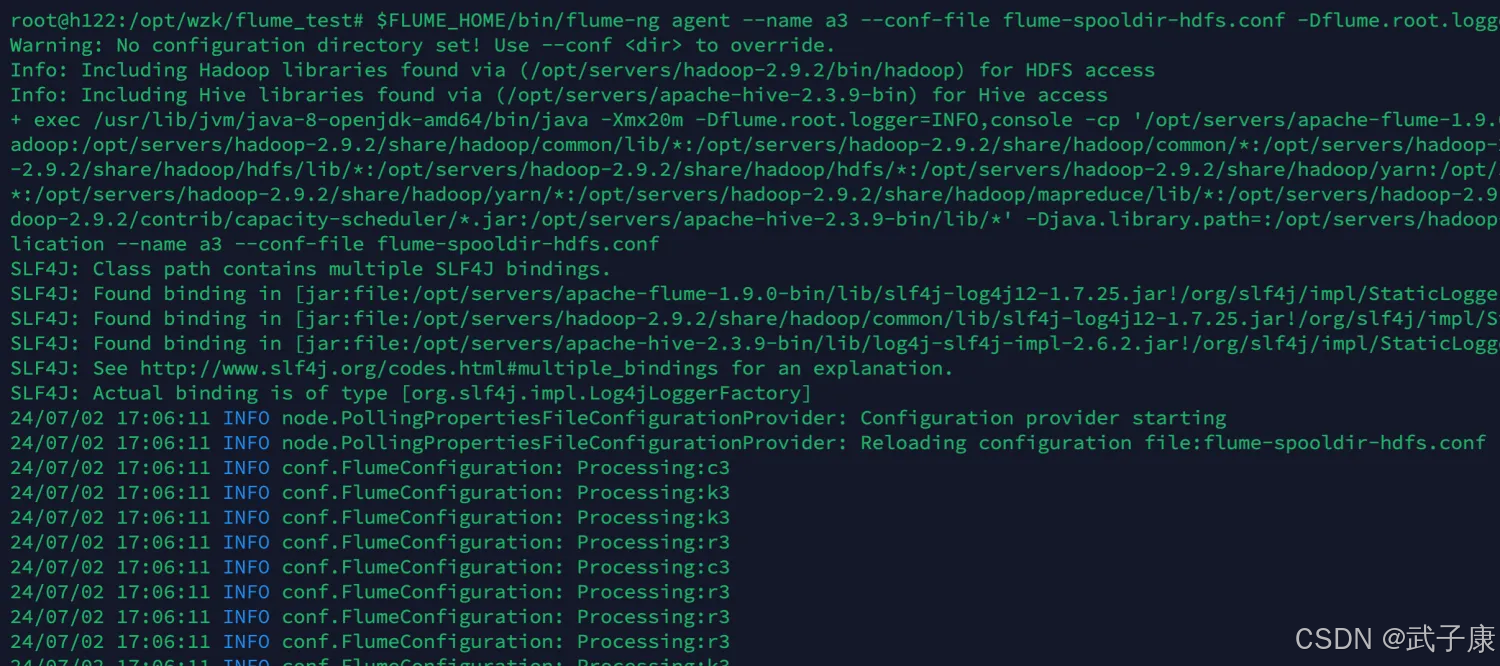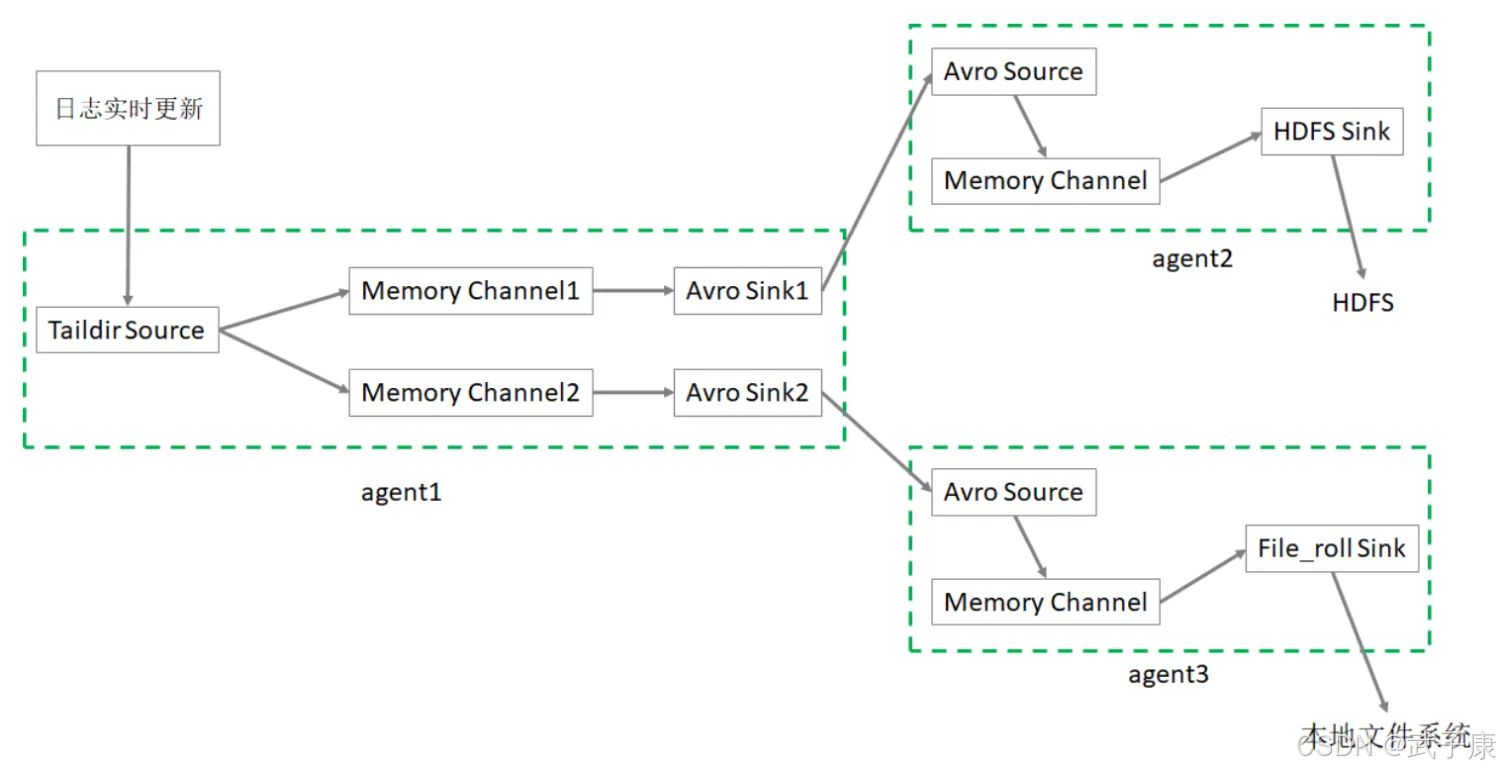点一下关注吧!!!非常感谢!!持续更新!!!
🚀 AI 篇持续更新中!(长期更新)
目前 2025 年 06 月 16 日更新到:AI 炼丹日志-29 - 字节跳动 DeerFlow 深度研究框斜体样式架 私有部署 测试上手 架构研究,持续打造实用 AI 工具指南!📐🤖
💻 Java 篇正式开启!(300 篇)
目前 2025 年 06 月 23 日更新到:Java-53 深入浅出 Tomcat 性能优化 JVM 内存模型 垃圾回收 GC Tomcat 配置优化 MyBatis 已完结,Spring 已完结,Nginx 已完结,Tomcat 已完结,分布式服务正在更新!深入浅出助你打牢基础!
📊 大数据板块已完成多项干货更新(300 篇):
包括 Hadoop、Hive、Kafka、Flink、ClickHouse、Elasticsearch 等二十余项核心组件,覆盖离线+实时数仓全栈!目前 2025 年 06 月 13 日更新到:大数据-278 Spark MLib - 基础介绍 机器学习算法 梯度提升树 GBDT 案例 详解
章节内容
上一节完成了如下的内容:
编写 Agent Conf 配置文件
收集 Hive 数据
汇聚到 HDFS 中
测试效果
背景介绍
这里是三台公网云服务器,每台 2C4G,搭建一个 Hadoop 的学习环境,供我学习。
2C4G 编号 h121
2C4G 编号 h122
2C2G 编号 h123
文档推荐
除了官方文档以外,这里有一个写的很好的中文文档:https://flume.liyifeng.org/
组件介绍
这里会对组件进行一个基本的介绍
Source(数据源)
常用如:
taildir-source:高性能监听文件(推荐)
exec-source:一次性执行命令(不推荐用于持续采集)
spooldir-source:监听指定目录新文件
Channel(缓存通道)
使用 Multiplexing Channel Selector 配合多 sink 实现“双写”:
Sink(目标输出)
监控目录
业务需求
Source
选择 spooldir,因为 spooldir 能够保证数据不丢失,且能够进行断点续传,但是延迟较高,不能实时监控。
Channel
选择 memory
Sink
选择 HDFS
需要注意
生产环境
如果在生产环境中,我们的基本逻辑是:
这种“双写”机制实现了实时 + 离线混合架构,满足以下需求:
实时处理:秒级告警 / 监控系统
离线分析:日报、月报、数据仓库
[日志源,如Nginx、APP等] ↓ Flume Source (taildir / exec / spooling) ↓ Flume Channel (Memory + File) ↓ ┌────────────┬────────────┐ ↓ ↓ Flume Sink1 (Kafka) Flume Sink2 (HDFS)
复制代码
配置样例
这里放一个 Demo
# Source 配置agent.sources.source1.type = TAILDIRagent.sources.source1.filegroups = f1agent.sources.source1.filegroups.f1 = /data/logs/nginx/access.log
# Channel 配置(内存和文件双通道)agent.channels.memoryChannel.type = memoryagent.channels.memoryChannel.capacity = 10000
agent.channels.fileChannel.type = fileagent.channels.fileChannel.checkpointDir = /var/log/flume/checkpointagent.channels.fileChannel.dataDirs = /var/log/flume/data
# Sink1: Kafkaagent.sinks.kafkaSink.type = org.apache.flume.sink.kafka.KafkaSinkagent.sinks.kafkaSink.topic = nginx-logsagent.sinks.kafkaSink.brokerList = localhost:9092
# Sink2: HDFSagent.sinks.hdfsSink.type = hdfsagent.sinks.hdfsSink.hdfs.path = hdfs://namenode:8020/logs/nginx/%Y-%m-%d/agent.sinks.hdfsSink.hdfs.fileType = DataStreamagent.sinks.hdfsSink.hdfs.writeFormat = Text
# Channel 绑定agent.sources.source1.channels = memoryChannel fileChannelagent.sinks.kafkaSink.channel = memoryChannelagent.sinks.hdfsSink.channel = fileChannel
复制代码
这里我们需要注意
多通道绑定:Source 支持绑定多个 Channel,Sink 各自绑定
数据一致性:Flume 自身无强一致保证,但文件 channel 比 memory channel 更可靠
容错机制:HDFS Sink 支持自动创建目录、滚动文件、断点续传
性能调优:可设置 bufferSize、batchSize、rollInterval 提升性能
使用建议
重要数据一定要落 HDFS 一份,避免 Kafka 异常导致数据丢失
Kafka 通道选 memory channel,速度更快
HDFS 落盘建议设置 rollInterval=60、batchSize=1000 适配大吞吐
落盘路径按天/小时分目录,例如:
hdfs.path = /logs/nginx/%Y/%m/%d/%H/
复制代码
此外我们常见的还会遇到如下的问题:
数据延迟写入 HDFS:batch size 太大,rollInterval 太长,降低 batchSize 或缩短 rollInterval
Kafka 中数据丢失:memory channel 崩溃丢缓存,使用 file channel 或启用 Kafka ACK 机制
HDFS 写入失败:权限、网络、文件系统故障,开启 Flume 日志调试,检查路径和权限
配置文件
cd /opt/wzk/flume_testvim flume_spooldir-hdfs.conf
复制代码
我们需要写入如下内容
# Name the components on this agenta3.sources = r3a3.channels = c3a3.sinks = k3# Describe/configure the sourcea3.sources.r3.type = spooldir# 注意这里的文件夹 换成自己的!!!a3.sources.r3.spoolDir = /opt/wzk/uploada3.sources.r3.fileSuffix = .COMPLETEDa3.sources.r3.fileHeader = true
# 忽略以.tmp结尾的文件,不上传a3.sources.r3.ignorePattern = ([^ ]*\.tmp)# Use a channel which buffers events in memorya3.channels.c3.type = memorya3.channels.c3.capacity = 10000a3.channels.c3.transactionCapacity = 500# Describe the sinka3.sinks.k3.type = hdfs# 注意修改成你自己的IP!!!a3.sinks.k3.hdfs.path = hdfs://h121.wzk.icu:9000/flume/upload/%Y%m%d/%H%M
# 上传文件的前缀a3.sinks.k3.hdfs.filePrefix = upload-# 是否使用本地时间戳a3.sinks.k3.hdfs.useLocalTimeStamp = true# 积攒500个Event,flush到HDFS一次a3.sinks.k3.hdfs.batchSize = 500# 设置文件类型a3.sinks.k3.hdfs.fileType = DataStream# 60秒滚动一次a3.sinks.k3.hdfs.rollInterval = 60# 128M滚动一次a3.sinks.k3.hdfs.rollSize = 134217700# 文件滚动与event数量无关a3.sinks.k3.hdfs.rollCount = 0# 最小冗余数a3.sinks.k3.hdfs.minBlockReplicas = 1
# Bind the source and sink to the channela3.sources.r3.channels = c3a3.sinks.k3.channel = c3
复制代码
启动 Agent
$FLUME_HOME/bin/flume-ng agent --name a3 \--conf-file flume-spooldir-hdfs.conf \-Dflume.root.logger=INFO,console
复制代码
测试效果
Flume
cd /opt/wzk/uploadvim 1.txt
复制代码
随便向其中写入一些内容,并保存,可以看到 Flume 已经有反应了。
HDFS
查看 HDFS,也已经有内容了
采集双写
这里业务上需要:
Flume 将数据写入本地
Flume 将数据写入 HDFS
分析实现
配置文件 1
配置文件包含如下内容:
1 个 taildir source
2 个 memory channel
2 个 avro sink
新建文件
vim flume-taildir-avro.conf
复制代码
写入如下内容
# Name the components on this agenta1.sources = r1a1.sinks = k1 k2a1.channels = c1 c2# 将数据流复制给所有channela1.sources.r1.selector.type = replicating# sourcea1.sources.r1.type = taildir# 记录每个文件最新消费位置a1.sources.r1.positionFile = /root/flume/taildir_position.jsona1.sources.r1.filegroups = f1# 备注:.*log 是正则表达式;这里写成 *.log 是错误的a1.sources.r1.filegroups.f1 = /tmp/root/.*log# sinka1.sinks.k1.type = avroa1.sinks.k1.hostname = linux123a1.sinks.k1.port = 9091a1.sinks.k2.type = avroa1.sinks.k2.hostname = linux123a1.sinks.k2.port = 9092# channela1.channels.c1.type = memorya1.channels.c1.capacity = 10000a1.channels.c1.transactionCapacity = 500a1.channels.c2.type = memorya1.channels.c2.capacity = 10000a1.channels.c2.transactionCapacity = 500# Bind the source and sink to the channela1.sources.r1.channels = c1 c2a1.sinks.k1.channel = c1a1.sinks.k2.channel = c2
复制代码
配置文件 2
配置文件包含如下内容:
1 个 avro source
1 个 memory channel
1 个 hdfs sink
新建配置文件
写入如下的内容:
# Name the components on this agenta2.sources = r1a2.sinks = k1a2.channels = c1# Describe/configure the sourcea2.sources.r1.type = avroa2.sources.r1.bind = linux123a2.sources.r1.port = 9091# Describe the channela2.channels.c1.type = memorya2.channels.c1.capacity = 10000a2.channels.c1.transactionCapacity = 500# Describe the sinka2.sinks.k1.type = hdfsa2.sinks.k1.hdfs.path = hdfs://linux121:8020/flume2/%Y%m%d/%H# 上传文件的前缀a2.sinks.k1.hdfs.filePrefix = flume2-# 是否使用本地时间戳a2.sinks.k1.hdfs.useLocalTimeStamp = true# 500个Event才flush到HDFS一次a2.sinks.k1.hdfs.batchSize = 500# 设置文件类型,可支持压缩a2.sinks.k1.hdfs.fileType = DataStream# 60秒生成一个新的文件a2.sinks.k1.hdfs.rollInterval = 60a2.sinks.k1.hdfs.rollSize = 0a2.sinks.k1.hdfs.rollCount = 0a2.sinks.k1.hdfs.minBlockReplicas = 1# Bind the source and sink to the channela2.sources.r1.channels = c1a2.sinks.k1.channel = c1
复制代码
配置文件 3
配置文件包含如下内容:
1 个 avro source
1 个 memory channel
1 个 file_roll sink
新建配置文件
写入如下的内容
# Name the components on this agenta3.sources = r1a3.sinks = k1a3.channels = c2# Describe/configure the sourcea3.sources.r1.type = avroa3.sources.r1.bind = linux123a3.sources.r1.port = 9092# Describe the sinka3.sinks.k1.type = file_roll# 目录需要提前创建好a3.sinks.k1.sink.directory = /root/flume/output# Describe the channela3.channels.c2.type = memorya3.channels.c2.capacity = 10000a3.channels.c2.transactionCapacity = 500# Bind the source and sink to the channela3.sources.r1.channels = c2a3.sinks.k1.channel = c2
复制代码
启动 Agent1
$FLUME_HOME/bin/flume-ng agent --name a3 \--conf-file ~/conf/flume-avro-file.conf \-Dflume.root.logger=INFO,console &
复制代码
启动 Agent2
$FLUME_HOME/bin/flume-ng agent --name a2 \--conf-file ~/conf/flume-avro-hdfs.conf \-Dflume.root.logger=INFO,console &
复制代码
启动 Agent3
$FLUME_HOME/bin/flume-ng agent --name a1 \--conf-file ~/conf/flume-taildir-avro.conf \-Dflume.root.logger=INFO,console &
复制代码
Hive 测试
hive -e "show databases;"
复制代码

















评论